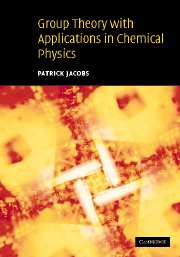Book contents
- Frontmatter
- Contents
- Preface
- Notation and conventions
- 1 The elementary properties of groups
- 2 Symmetry operators and point groups
- 3 Matrix representatives
- 4 Group representations
- 5 Bases of representations
- 6 Molecular orbitals
- 7 Crystal-field theory
- 8 Double groups
- 9 Molecular vibrations
- 10 Transitions between electronic states
- 11 Continuous groups
- 12 Projective representations
- 13 Time-reversal symmetry
- 14 Magnetic point groups
- 15 Physical properties of crystals
- 16 Space groups
- 17 Electronic energy states in crystals
- 18 Vibration of atoms in crystals
- Appendices
- References
- Index
14 - Magnetic point groups
Published online by Cambridge University Press: 10 December 2009
- Frontmatter
- Contents
- Preface
- Notation and conventions
- 1 The elementary properties of groups
- 2 Symmetry operators and point groups
- 3 Matrix representatives
- 4 Group representations
- 5 Bases of representations
- 6 Molecular orbitals
- 7 Crystal-field theory
- 8 Double groups
- 9 Molecular vibrations
- 10 Transitions between electronic states
- 11 Continuous groups
- 12 Projective representations
- 13 Time-reversal symmetry
- 14 Magnetic point groups
- 15 Physical properties of crystals
- 16 Space groups
- 17 Electronic energy states in crystals
- 18 Vibration of atoms in crystals
- Appendices
- References
- Index
Summary
Crystallographic magnetic point groups
Because the neutron has a magnetic moment, neutron diffraction can reveal not only the spatial distribution of the atoms in a crystal but also the orientation of the spin magnetic moments. Three main kinds of magnetic order can be distinguished. In ferromagnetic crystals (e.g. Fe, Ni, Co) the spin magnetic moments are aligned parallel to a particular direction. In antiferromagnetically ordered crystals, such as MnO, the spins on adjacent Mn atoms are antiparallel, so there is no net magnetic moment. In ferrimagnetic crystals (ferrites, garnets) the antiparallel spins on two sublattices are of unequal magnitude so that there is a net magnetic moment. In classical electromagnetism a magnetic moment is associated with a current, and consequently time reversal results in a reversal of magnetic moments. Therefore the point groups G of magnetic crystals include complementary operators ΘR, where Θ is the time-reversal operator introduced in Chapter 13. The thirty-two crystallographic point groups, which were derived in Chapter 2, do not involve any complementary operators. In such crystals (designated as type I) the orientation of all spins is invariant under all R ∈ G. In Shubnikov's (1964) description of the point groups, in which a positive spin is referred to as “black” and a negative spin as “white,” so that the time-reversal operator Θ induces a “color change,” these groups would be singly colored, either black or white.
- Type
- Chapter
- Information
- Group Theory with Applications in Chemical Physics , pp. 265 - 281Publisher: Cambridge University PressPrint publication year: 2005



